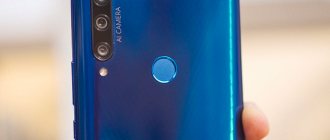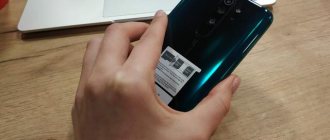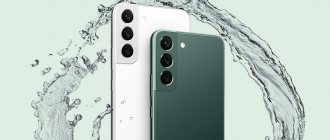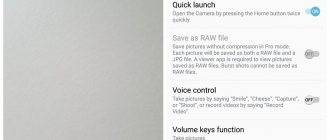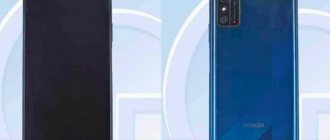Huawei P10 turned out, on the one hand, to be quite an interesting smartphone, but on the other, somehow passable and even slightly strange. You use it and everything seems cool and cool, but still something is not right. The build quality is excellent, the characteristics are excellent, the cameras take excellent pictures, but there is still something missing. In this review we will try to figure out what it is.
Contents:
— Equipment — Design — Convenience and control — Display — Characteristics — Performance — Photo and video capabilities — Software shell — Sound quality — Battery life — Summary
Equipment
This is what I understand! You unpack the Huawei P10 and are amazed at how interesting everything is arranged inside: everything is thought out, laid out in its own boxes, and so on. It’s more impressive than unpacking the iPhone 7, and I was one of the first in the world to do this in September, so I know what I’m talking about.
This is how you unbox an iPhone 7? I took off the protective film, opened the lid, took out the device, took out the partition, and there was a charger, cable and headphones with an adapter. One thought is spinning in my head: “Is that all? At what point was the arrival supposed to take place?”
With P10 everything is much more interesting. First, we take out the phone, which comes from the factory with a perfectly glued protective film. No seller on Euroset will stick it on you like that, so don’t take it off, it’s of high quality.
Then we take out the partition, inside of which the plastic case is hidden. Since at first it is difficult to find at least some accessory for new products like the P10, to put it mildly, the case will come in handy.
Next we have two boxes. What's in each of them? One contains a USB Type-C cable and a wired headset (they didn’t skimp!). Another hefty charger with support for SuperCharge is fast charging from Huawei. Later I'll tell you how it works. Each individual box like this hides something inside, creates a little intrigue and it’s cool.
Overall, I give it a clear A for the kit and the unboxing experience!
Design
I get the impression that the P10 series and other smartphones (Mate 9, for example) are being developed by different people from different companies. The flagship Mate 9 is so solid, large, beautiful and ergonomic.
Huawei P10 is the best possible illustration of the so-called Chinese design. And that's why.
At the presentation, all journalists were given free samples. Some people got black, some white, but I was “lucky” with blue. I can say one thing - I liked this option the least, although the colors look original.
There are various established design techniques on the market. These are edges turned on a CNC machine, polished to a shine, as if lacquered metal, strips of antennas, which this season are customarily bent, as in the iPhone 7, all sorts of ribbed surfaces, glass, under which a body with an interesting graphic structure is hidden, and so on. In general, there are enough options to somehow play up the appearance of your product.
The main thing here is not to go too far, to use all design techniques in moderation. However, this is not about Huawei P10.
Let's take one of the corners of the device, what do we see here?
Metal polished to a high gloss, I don’t understand why there was an antenna strip stuck in there (apparently to be like the iPhone 7) and a ribbed back.
Here's a pink version that doesn't have that "grater" on the back. However, here the eye catches on the glass located at the top of the smartphone. It reflects beautifully, but against the backdrop of a minimalist lid it looks a little overloaded.
The smartphone seems to look stylish and sophisticated, but you look at the top and... hand-face.
Go ahead. On the right side there is a power button, which for some reason is highlighted in red, and also has a jagged surface. It seems to me that the key is already clearly distinguishable to the touch and does not need additional highlighting.
However, I am sure that such a tacky appearance will not affect sales in any way. In Europe, the smartphone is advertised as aggressively as possible. Here's an example - on one of the main squares in Barcelona - Plaza Catalunya - a huge Huawei banner has squeezed out two entire facades of the house. A little higher up one of the central streets the situation repeats itself. In the depths of the Gothic Quarter, everything is the same.
Two or three years ago only Samsung could afford this, but now the Chinese have caught up. In general, all this is a sure sign that Huawei will further increase its market share this year, and next year it may actually overthrow the giant Apple from second place. At this rate.
Convenience and control
The P10 tried to transfer the control of the smartphone to a touch button under the screen, which also doubles as a fingerprint scanner. Did it work? Let's see.
One short press is a step back. All clear. A long press returns to the main screen and this is a problem.
It would seem, what’s wrong? And the fact is that this scheme is never ergonomic.
How is this implemented by competitors, for example, in the same devices from Meizu. Touched - step back, pressed - exit to the main screen. In iPhone 7 everything is the same. The principle is extremely simple and clear, you get used to it literally in 5 minutes once and for all. In P10 you will constantly get confused: either you didn’t hold it in, or you held it too long and went to the main screen, although you just had to go back a step.
And now a test in the head. In Meizu, the latest running applications are literally pulled out from under the screen - you need to swipe your finger up from the bottom edge of the display. Very convenient, no mistakes.
Here it is done as follows. You need to swipe clearly across the narrow touch pad from left to right. This doesn’t always work out, because often you just make the transition back. In addition, when you operate a smartphone on the go, with one hand, pressing, swiping and doing other things is quite sloppy. And here you have to stop and make a clear gesture, otherwise the device will not understand you.
However, the fingerprint scanner works perfectly! It is very fast, almost the same as in OnePlus 3T, and everything is far from it, including flagships from A-brands. There are no mistakes either - in 100 out of 100 cases the device is unlocked, opens locked applications, and so on.
Now about convenience in general. The smartphone fits perfectly in the hand. Fans of compact devices will be very pleased, because it can be easily operated with one hand. Of course, there are all sorts of one-handed control modes, but you won’t need them, because everything is ergonomic anyway.
| Length | Width | Thickness | Weight | |
| Huawei P10 (5.1) | 145,3 | 69,3 | 6,98 | 145 |
| iPhone 7 (4.7) | 138,3 | 67,1 | 7,1 | 138 |
| Samsung Galaxy S7 (5.1) | 142,4 | 69,6 | 7,9 | 152 |
In 2022, all flagships should receive a case protected from dust and moisture on all fronts, that is, IP67 protection. The fashion trend has bypassed the P10 and only slightly affected the older model, the P10 Plus. It has a special nano-coating that supposedly repels moisture, but the device cannot be immersed in water.
Display
Beautiful, bright, quite rich (for IPS) screen. There is absolutely nothing to complain about.
- display diagonal 5.1 inches
- resolution 1920 x 1080 pixels
- dot density per square inch 432 ppi
There are no problems with viewing angles either. Below in the photo we compare the screens of our hero (bottom and left) with the OnePlus 3T display (top and right).
The 5th generation Corning Gorilla Glass is used, but there is one oddity.
Surprisingly, the P10 does not have a very high-quality oleophobic coating.
The screen gets dirty with fingerprints very quickly and they are somehow not very willing to be erased. Don't get me wrong, the fingerprint protection is good, it's just worse than most flagships.
There is a possibility that this is due to the fact that I had a sample in my hands that is not intended for sale and, perhaps, by the time of release the smartphone will acquire a full-fledged oleophobic coating befitting a flagship.
Communications
As the Huawei P10 lite blue 32gb ram 4gb review showed, there is support for Russian LTE frequencies, which ensures high data transfer speeds. For navigation, you can use one of the following systems: GPS, GLONASS, Galileo or Beidou. On average, searching for satellites takes about 20 seconds.
Conclusion
While reviewing the Huawei p10 phone, we came to the conclusion that this is one of the best offers on the Chinese phone market, which has everything that users need - good autonomy, excellent sound, display, performance and most importantly - a dual camera that shoots at a professional level. Other features include a large selection of color options at the time of purchase, which distinguishes the device from its competitors. But there are some things to complain about, for example, the lack of an oleophobic coating and a weak level of protection for the back, which forces you to carry your smartphone in a case. We will be very grateful if you leave Huawei P10 lite black owner reviews in the comments to our article.
Where can I buy?
Following the links you can buy a smartphone at the best prices:
Aliexpress Gearbest
Huawei Honor 5c - review, price and specifications
Huawei Honor 3C is a modern smartphone with excellent characteristics
Huawei Nova 2 is a smartphone whose main feature is its cameras
Huawei P Smart review - how good is the budget phone?
Huawei Nova 2i is the world's first smartphone with four cameras
Huawei Honor 6C Pro is a bright representative of the budget category
Review of Huawei Honor 9 Lite - what did you have to sacrifice to significantly reduce the price of the flagship?
Huawei Y6 II - pros and cons of a mid-priced smartphone
Technical specifications of Huawei P10 (model VTR-L29)
- Kirin 960 processor with 4 Cortex A73 cores with a frequency of 2.4 GHz and 4 other Cortex A53 cores operating at a frequency of 1.8 GHz
- Mali-G71 MP8 graphics
- RAM 4 GB LPDDR4 (after reboot free 2291 MB)
- built-in memory 32 or 64 GB (49.62 GB available for user)
- support for Micro SD cards in place (the slot is combined with a SIM card)
- IPS display with a diagonal of 5.1 inches and a resolution of 1920 x 1080 pixels (432 ppi)
- 8 MP front camera (f/1.9 aperture, 6 lenses, FHD video recording, image stabilization)
- main camera 20 MP – monochrome sensor plus 12 MP – RGB matrix (f/2.2, optical stabilization, dual LED flash, 2x hybrid zoom, PDAF, CAF and laser focusing, 4K recording at 30 fps)
- 3,200 mAh battery + SuperCharge fast charging
- USB Type-C 2.0 connection ports (OTG works), 3.5 mm audio output (supports 192 KHz and 24-bit audio)
- OS Android 7.0
- EMUI 5.1 shell
- sensors: accelerometer, light and proximity sensors, fingerprint scanner, gyroscope, compass, Hall sensor
- Dimensions: 145.3 x 69.3 x 7 mm
- weight 145 grams
- available body colors: blue, black, pink, green, white and silver
A small note. It always amuses me how manufacturers play with certain characteristics. The official website states that, for example, the case width is 69.3 millimeters. At the same time, it is indicated that the thickness here is 6.98 mm. That is, there is no rounding to tenths of a millimeter. It is important for the company to show that the thickness of the case is less than 7 mm and does not care that we are talking about an insignificant 2 hundredths of a millimeter.
| Length | Width | Thickness | Weight | |
| Huawei P10 (5.1) | 145,3 | 69,3 | 6,98 | 145 |
| iPhone 7 (4.7) | 138,3 | 67,1 | 7,1 | 138 |
| Samsung Galaxy S7 (5.1) | 142,4 | 69,6 | 7,9 | 152 |
Wireless technologies:
- LTE Cat. 12 (20 4G bands)
- Wi-Fi (802.11 ac, 2.4 and 5 GHz, MIMO 2×2), Bluetooth 4.2, NFC
- support for two Nano SIM cards (one combined with a compartment for Micro SD)
- Navigation: GPS, Glonass, Beidou, Galileo
Many will also be interested in the fact that the device has one radio module installed.
Let me tell you more about the chipset, which is the “brains” of our hero. So, Kirin 960 is Huawei’s top solution today. Developed on the basis of 16nm process technology. The transition to a 10-nanometer process technology is expected this year and it will be a “stone” called Kirin 970. Our chipset includes two clusters of 4 cores each:
- Cortex A73 @ 2.4 GHz
- Cortex A53 – 1.8 GHz
Separately about the video chip, because it uses a new generation of Mali G71 graphics with 8 cores operating at a frequency of up to 1037 MHz (according to other sources, up to 900 MHz). Compared to the previous Mali-T880, the new video accelerator should be 50 percent more powerful and 20 percent more efficient on battery resources.
So the G71 is a solution worthy of a real flagship.
A little about navigation. Because, unfortunately, there is something to be said.
Firstly, the accuracy of location determination is poor. Either you are walking on the roof of a building, or driving along the side of the road - this happens.
Secondly, I was not very pleased with the speed of identifying a point on the map. So, in Google Maps on any smartphone with a “stone” from Qualcomm, the radius of your location narrows very quickly, and after a few seconds there is only your point on the map and without errors. In the case of P10, the radius can either increase or decrease for quite some time.
However, the cold start is very fast and lasts about five seconds.
Many are also concerned about the number of radio modules. If there were two of them, and in our case there is only one, then it would be possible to talk on one SIM card, while remaining online on the other. But this time it didn’t work out.
Connection
The P10 plus smartphone is configured to work with the following networks:
- 4G TD-LTE: bands 38, 39, 40;
- 4G FDD LTE: bands 1, 2, 3, 4, 5, 7, 8, 9, 12, 17, 18, 19, 20, 26, 28, 29;
- 3G UMTS (WCDMA), HSPA+, DC-HSDPA: bands 1, 2, 4, 5, 6, 8, 19;
- 2G GSM, EDGE: 850, 900, 1800, 1900 MHz.
Also, the Chinese flagship can work with a wide variety of navigation satellites, including devices: GPS, GLONASS, Galileo and Beidou. To detect the first fifteen satellites during a cold start, the smartphone needs about 45 seconds; when searching again, it finds the same number of satellites in 2 seconds.
As for a telephone conversation, the connection with the P10 is quite stable, the sound is clear, and the voice of the interlocutor seems as familiar as in a personal meeting. On the other hand, we would be very surprised if a smartphone of this level had a lower quality performance of the most important element of any telephone device.
Performance
The system works perfectly, does not lag or slow down. The feeling that you have a flagship in your hands is present most of the time.
And all because from time to time certain applications slow down. I caught some pretty decent lags on Instagram and Google Maps. Using cards on this device, it seems that in front of you is some kind of budget device for 100 bucks, and not a top-end device for 650 dollars. Otherwise no problems.
Here's another bottleneck. Let's say the phone lay there all day without being connected to the Internet. In the evening you turn on Wi-Fi and about 100 notifications per second arrive on your device. At this moment, the smartphone begins to slow down terribly, the animation lags greatly. In general, under heavy load of several processes at the same time, the system falls into an inoperative state. For a short, but still noticeable time.
I am sure that all these points will be corrected in the coming versions of updates. After all, the smartphone hasn’t even gone on sale yet, so make a discount on application optimization, moreover, from third-party developers.
There is no need to worry about gaming performance at all. The graphical “stupidity” of the Mali-G71 is enough to run all modern 3D titles at maximum settings.
Thus, at the highest graphics settings in World of Tanks Blitz, performance did not drop below 61 frames per second when crossing polygons on a tank. As soon as the battles began, there were drops, but the minimum level was 35-41 fps, and this was more than enough for a comfortable game.
By the way, only during “tanks” did the smartphone begin to heat up noticeably. Not to say that it burned your hands, but you could warm up against it quite quickly.
In Asphalt Xtreme, everything races and accelerates without problems.
I don’t think anyone will have any doubts about the device’s ability to play 4K video. He writes these videos himself, so...
Moreover! To package video, it uses the modern H.265 codec, which is not played correctly on all desktop computers. The smartphone copes with them with a bang.
Now it's time to look at the results of synthetic tests. And here the P10 did not disappoint.
Camera
The P10 cameras are, on paper, some of the coolest cameras on the market. The module design was developed by the German company Leica, which has been producing professional-grade cameras for almost a century.
Huawei P10 is equipped with two main cameras at once - a 12-megapixel with an RGB sensor and a 20-megapixel with a monochrome sensor. When capturing a frame, sophisticated laser, phase detection and depth autofocus systems are used.
Thanks to the dual camera, you can use the wide aperture mode. It produces great photos with beautiful-looking bokeh (blurred backgrounds). There is optical stabilization, as well as 2x smooth zoom technology.
In the dark, objects in the pictures are illuminated by a dual LED flash. At dusk, the pictures turn out quite well, even despite a significant amount of noise spoiling the detail. To get rid of them, you can experiment with manual mode and long shutter speed shooting, but this will require a tripod.
The front 8-megapixel camera with autofocus is head and shoulders above most main cameras on Chinese smartphones. Selfies can be immediately improved (finishing facial tone, removing minor imperfections) in the standard camera application.
You can shoot in PRO mode, where you can manually adjust the main parameters: shutter speed, exposure compensation, focus, etc.
The P10 does a good job of recording Full HD and 4K video at 60fps.
If you want to buy a smartphone with an excellent camera, but cheaper than the iPhone 7, the Huawei P10 is definitely your choice. It will please both ordinary users and professional photographers.
Photo and video capabilities
This is almost the main feature of the smartphone. Huawei places a huge emphasis on this and for good reason. Looking ahead, I will say that the pictures from all three cameras (yes, yes) are of amazing quality. There are nuances, but overall the P10 is one of the top camera phones on the market now, in 2017.
During the testing process, I realized that it’s impossible to simply talk about the capabilities of a smartphone in terms of photo and video shooting in a review. There is too much material, examples of photographs and comments on them. And potential smartphone owners should be aware of all the nuances.
In general, I decided to make a separate article dedicated to photos and videos. Here is the link.
Software shell
It is based, of course, on Android 7.0. A proprietary software shell, EMUI 5.1, is installed on top.
It is very convenient, intuitive and functional. The user can customize a lot according to his taste and needs.
However, I personally don’t like literally all the themes pre-installed in the system. Strange wallpaper, adjusted to the background color of the icons, which are drawn in the style of Symbian OS of the late 2000s.
In general, all I can say is that EMUI 4.x looked much nicer. Nowadays there is literally nothing to choose from a heap of standard themes. Everything is kind of scanty, incomprehensible, some voluminous and ugly icons. In general, to find a suitable theme from an online catalog, you will have to spend quite a lot of time. After all, custom shells look even worse.
Of course, there was some advertising nonsense installed by default. In my case it was TripAdvisor, Booking and something else. I think that in the version for Russia there will be even more junk that is unnecessary for the user.
All manufacturers are now trying to pack their devices with some interesting functions. For example, I really like cloning any third-party program in Xiaomi's MIUI shell. You can use two different accounts in the original and in the copy of the utility.
Huawei made the same feature, only you can clone only two applications: WhatsApp and Facebook. Why other utilities cannot be replicated is unknown.
The review of the software in P10 turned out to be quite negative, but if we omit all these points, the EMUI 5.1 software add-on is simply wonderful. 99% of users will not have any problems with it, due to its logic and intuitiveness. Those who like to tinker with the settings will be able to do this to their heart's content, because in terms of functionality, EMUI has always been a leader.
Results
Huawei P10 is an excellent attempt by the Chinese company to impose a fight on the recognized leaders in the field. Huawei smartphones are developing in the right direction, especially given the low prices relative to competitors.
Huawei P10 can be ordered in the online store shop.huawei.com from 26,990 rubles.
Pros:
- Excellent main camera and its photo capabilities.
- Good selfie quality.
- Bright and contrasting display.
- Multifunctional proprietary shell EMUI 5.1 + Andoid Nougat.
- Fast and customizable front-panel fingerprint scanner.
- Stylish and laconic design.
- Excellent ergonomics and build quality, the smartphone is thin and light.
Minuses:
- Heating during loads (games and synthetic tests).
- Standard autonomy (not surprised).
Ratings: 1 , average: 5.00
Sound quality
There is only one external speaker, located to the right of the USB Type-C port. The playback quality through it is quite decent. It is moderately loud - above average, but most importantly it does not rattle or whistle at turned up volume. There are speakers with better sound quality and in significantly cheaper devices, but still.
The sound in the headphones is simply wonderful. Better than what is now considered the average standard among modern smartphones. With DTS enabled, the immersion becomes a little deeper and the soundstage a little richer.
I compared the performance of our hero with OnePlus 3T, which also did not fall from the sky. So, after P10, the sound on 1+3T is somewhat poor, a little flat - not that good, in general.
The built-in player is beautiful, but not very functional. No, of course, it can cleverly sort music into different tags and categories, and turn off using a timer, but there are no sound settings here. There is only the ability to turn on/off an enhancement called DTS.
If you turn the smartphone in a horizontal orientation, the player opens an interface that is very similar to the feature Apple killed some time ago called Cover Flow. It was a good idea and the guys from Huawei were great for picking it up.
Battery life
Work stated for 1.87 days. This is a very strange number. On the one hand, you can round it up to two days, but all this will be a theory that has little in common with reality.
In practice, a smartphone lives very little - one day of light in the off-season under a normal, quite normal load and 3 hours of display illumination. To be precise, 100% of the battery charge will disappear around 7-8 pm if you removed the device from charging around 8 am.
I inserted one SIM card, activated all possible wireless networks, and did not care about the detailed settings of the smartphone’s power consumption. And in this regard, by the way, the EMUI shell provides very decent tools. However, in my opinion, the user should not care about all these nuances, monitor the resource consumption of applications, and so on. The smartphone should do this for him, without limiting its owner in any way. In principle, P10 does this, but the output is still weak.
By the way, in the settings there is a function for setting a lower resolution, and in theory this should save battery power. After its activation, however, nothing happens. Nothing at all.
But when you connect the charger, a beautiful animation is displayed on the screen. And there is nothing wrong with the fact that it is very similar to the similar one in Meizu smartphones.
Now about the most important thing, because Huawei also has its own “fast charging”, whose name is SuperCharge. The kit comes with a power supply of very impressive dimensions, the characteristics of which are as follows:
- 5V - 2A
- 4.5V - 5A
- 5V - 4.5A
The power, unfortunately, is not indicated, however, the smartphone is charged from 0 to 100% in 1 hour 49 minutes, and this is with a battery capacity of only 3,200 mAh.
This can't even be called fast charging.
Battery
The P10 uses a 3,200 mAh battery with SuperCharge fast charging. In normal mode, the battery can last about a day. In energy saving mode, you can try to squeeze out as much as two days.
To achieve maximum operating time, you can change the screen resolution or limit the processor performance. A stress test with the game on, Wi-Fi and the screen at maximum brightness drained the smartphone in about 3 hours.

